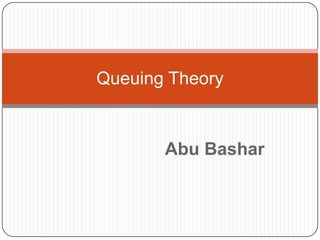
Queuing theory
- 1. Queuing Theory Abu Bashar
- 2. What is queuing ?? Queues or waiting lines arise when the demand for a service facility exceeds the capacity of that facility, that is, the customers do not get service immediately upon request but must wait, or the service facilities stand idle and wait for customers. Waiting lines, or queues are a common occurrence both in everyday life and in variety of business and industrial situations.
- 3. For example Supermarkets must decide how many cash register check out positions should be opened. Gasoline stations must decide how many pumps should be opened and how many attendants should be on duty. Manufacturing plants must determine the optimal number of mechanics to have on duty in each shift to repair machines that break down. Banks must decide how many teller windows to keep open to serve customers during various hours of the day.
- 5. BASIC COMPONENTS OF A QUEUING SYSTEM INPUT SOURCE OF QUEUE An input source is characterized by Size of the calling population Pattern of arrivals at the system Behavior of the arrivals
- 6. SERVICE SYSTEM The service is provided by a service facility (or facilities). This may be a person (a bank teller, a barber, a machine (elevator, gasoline pump), or a space (airport runway, parking lot, hospital bed), to mention just a few. A service facility may include one person or several people operating as a team. There are two aspects of a service system— (a) the configuration of the service system and (b) the speed of the service.
- 7. Configuration of the service system The customers’ entry into the service system depends upon the queue conditions. If at the time of customers’ arrival, the server is idle, then the customer is served immediately. By configuration of the service system we mean how the service facilities exist. Service systems are usually classified in terms of their number of channels, or numbers of servers.
- 8. Single Server – Single Queue The models that involve one queue – one service station facility are called single server models where customer waits till the service point is ready to take him for servicing. Students arriving at a library counter is an example of a single server facility.
- 9. Single Server – Several Queues In this type of facility there are several queues and the customer may join any one of these but there is only one service channel.
- 10. Several (Parallel) Servers – Single Queue In this type of model there is more than one server and each server provides the same type of facility. The customers wait in a single queue until one of the service channels is ready to take them in for servicing.
- 11. Several Servers – Several Queues This type of model consists of several servers where each of the servers has a different queue. Different cash counters in an electricity office where the customers can make payment in respect of their electricity bills provide an example of this type of model.
- 12. Service facilities in a series In this, a customer enters the first station and gets a portion of service and then moves on to the next station, gets some service and then again moves on to the next station. …. and so on, and finally leaves the system, having received the complete service. For example, machining of a certain steel item may consist of cutting, turning, knurling, drilling, grinding, and packaging operations, each of which is performed by a single server in a series.
- 13. Speed of Service In a queuing system, the speed with which service is provided can be expressed in either of two ways—as service rate and as service time. • The service rate describes the number of customers serviced during a particular time period. • The service time indicates the amount of time needed to service a customer. • Service rates and times are reciprocal of each other and either of them is sufficient to indicate the capacity of the facility. Thus if a cashier can attend, on an average 5 customers in an hour, the service rate would be expressed as 5 customers/hour and service time would be equal to 12 minutes/customer.
- 14. QUEUE DISCIPLINE The queue discipline is the order or manner in which customers from the queue are selected for service. There are a number of ways in which customers in the queue are served. Some of these are: Static queue disciplines are based on the individual customer's status in the queue. Few of such disciplines are: first-come, first-served (FCFS) service discipline. Last-come-first-served (LCFS) Dynamic queue disciplines are based on the individual customer attributes in the queue. Few of such disciplines are: Service in Random Order (SIRO)
